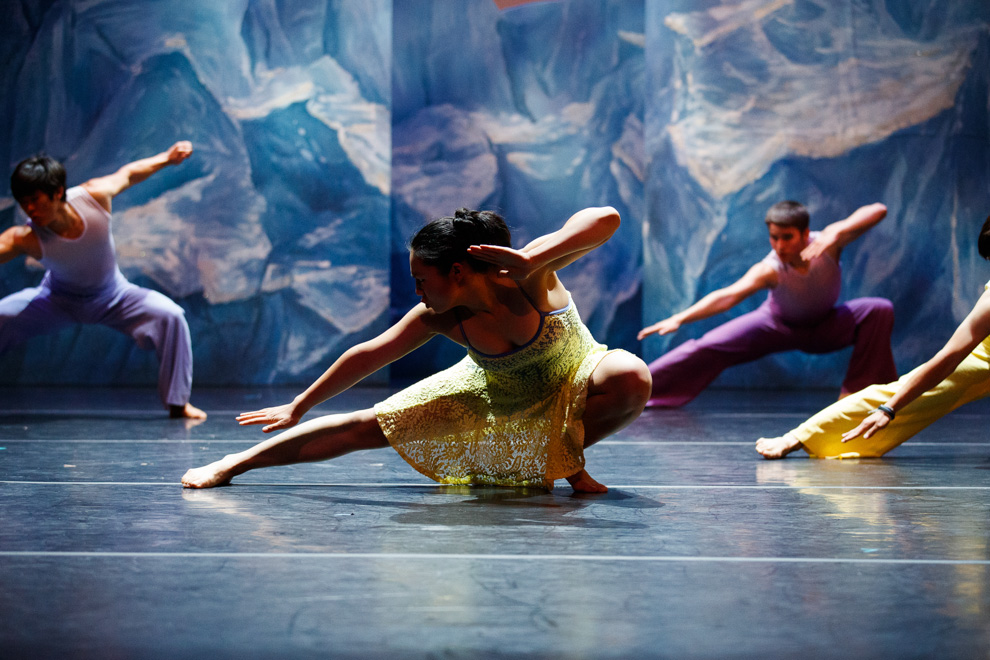Contemporary dance offers a unique style of artistic expression. It offers the chance to display beauty and grace through movement. It can tell a story or explore meaning. It exults the human form. On the Memorial Auditorium stage in the Theater and Performance Studies dance showcase ‘Spatial Shift,’ contemporary dance celebrates an often overlooked side of the TAPS department. Through four unique pieces, ‘Spatial Shift’ highlights the talent and expertise of the choreographers and dancers alike.
As a showcase, ‘Spatial Shift’ centers on the theme of space: the definition of space, and how we interact in and with it. As choreographer Diane Frank notes, “dance is, above all and fundamentally, the body in action over time and through space.”
‘Spatial Shift’ opens with “Spring Charrette,” choreographed by Aleta Hayes. The term “charrette,” in its current usage, refers to a collaborative process, through which artists work to resolve some challenge of design. Aptly named, Hayes’ piece demonstrates collaboration in the creative process, seamlessly incorporating differing dance styles and design elements into one cohesive vision. Rather than a dance set to some backing track, “Spring Charrette” includes a live DJ (Patrick Lotilla), vocalist (Aaron Grayson) and drummer (Daniel Guaqueta). The movement itself is varied, ranging from contemporary lyrical to a style resembling form sequences in Tae Kwon Do. What could easy devolve into chaos blends.
Though times some techniques feel stunted, an extension not fully elongated, a movement stopped short of its natural finish, the overall quality and precision of the dance outshines these minute missteps. All bodies are bursting with energy, even in moments of stillness. As the dancers cut through the space, they wash the stage with joy and pride in the work they have created.
The showcase continues with “New Work,” choreographed by Robert Moses. Transitioning into this second piece, the stage contracts with the use of a scrim, condensing the dancing to the space downstage of the proscenium arch. The movement in the piece is precise, underscored by the heavy drums of the backing track. Unfortunately, such music calls for perfection, and slight mistakes are more noticeable than in a lyrical piece, in which the legato movement more easily hides asynchronicity. The dancers, however, recover quickly from mistakes, and hiccups in the flow of the piece are limited.
The third segment of the showcase is “Poem (Fragment Expansion),” choreographed by Alex Ketley. The first moments of the piece are breathtaking. A single dancer enters the stage by crawling onto it from the front of the house, and begins a solo performance downstage center. Dancing in silence, she is captivating. Even without an audible external rhythm, her dancing is fluid and precise – the movement feels natural and dynamic when it might otherwise feel forced and uncomfortable. As the music begins, the scrim rises and the stage opens to reveal an entire ensemble.
Ketley’s choreography is engaging, balanced in the level of complexity, in turn capturing the audience’s attention and maintaining a simple elegance that keeps the performance sharp. The piece is staged around a set of tables for the dancers to engage with: around and under. At times, the group lacks unison, an unfortunate shortcoming in a piece that demands sharp, pointed movements. Luckily, the piece transitions from sequence to sequence often enough that the disjointed moments are brief.
The final piece of the showcase is “Branch, Tendril, Vine,” choreographed by Diane Frank. Characterized by softer, graceful movement, the piece is arguably the most lyrical of the showcase. Frank’s choreography is unique in its ability to feature many dancers and movements at once without feeling overwhelming. The ensemble moves across the stage in what initially seems like a group of individual dances lumped together, but a closer look reveals sets of dancers in unison consciously spaced. There is clear intentionality behind the choreography, despite infrequent questionable moments. Particularly impressive is the partner work within the piece, as pairs cooperate impeccably together to paint the space with their dancing. Even the lifts are effortless and natural. “Branch, Tendril, Vine” provides a satiating close the showcase.
The design of the showcase wonderfully complements the dances and provides a consistent thematic undercurrent. The lighting (Stephen Hitchcock ’18) enhances each performance, adding an artistic element that highlights the dancers rather than becoming a distracting presence. Connie Strayer’s costume design is elegant and appropriate, as the costumes flatter the dancers and allow them the flexibility needed. No piece is gaudy or out of place, and each draws focus to the forms the choreographers have worked to create. The set design (Erik Flatmo) adds metaphorical meaning to the pieces, helping define the space of the dance. One particularly beautiful piece is a disc abstractly resembling a clock that slowly cuts across the stage throughout the fourth and final dance.
‘Spatial Shift’ serves as a beautiful culmination of the academic year for the Theater and Performance Studies department. The performance showcases the immense talent of the choreographers within the department, and provides an opportunity for gifted students to partake in a creative and professional environment to produce something spectacular. ‘Spatial Shift’ is well worth every second, a time to celebrate contemporary dance and revel in the beauty the body can create.
Contact Alejandra Aguilar [email protected].
